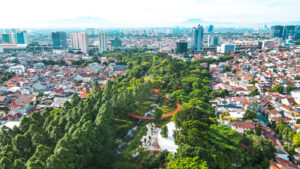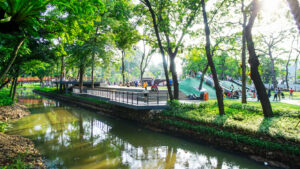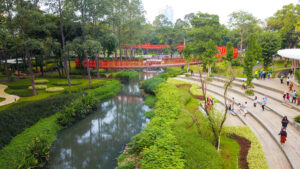
Park in Jakarta falls victim to its own success
By Michael Casey
The pilot park in Jakarta that’s fallen victim to its own success quickly implements a revised park management plan.
It was an email I received from an industry news outlet that captured my initial attention related to an innovative project that was in the pipeline for the people of South Jakarta. It was described as a park that would integrate green and social spaces into an existing public park which involved the collaboration of multi government agencies. What transpired on a recent visit to this park (which is still in the pilot phase), is that the park had become such a popular destination for the people of South Jakarta that it fell victim to its own success.
Introducing Tebet Eco Park (TEP), located in Jakarta, a large-scale example of a best-practice landscape design approach. I had the pleasure of visiting this park just recently in August 2022, and upon entering the park, I could have sworn I was in Singapore as it mirrored their mature green spaces.
Tebet Eco Park is located close to the central business district of Jakarta which is one of the oldest neighborhoods in south Jakarta. The landscape project, designed by the team at Siura Studio, is a multi-stakeholder collaboration between the many agencies inside the provincial government, and a private sector developer, PT Award Global Infinity, and now sits under the management and care of DKI Jakarta City Parks and Forest Services.
TEP is two parks that are divided by a main road which spans seven hectares, or approximately 17 acres, and features a river that dissects the middle of this space. The Ciliwung River is the city’s longest waterway, extending over 120km and was originally slated to be the centre of Tebet’s ‘garden city’ concept. However, during the planning phase, it instead became utilised for housing and developed areas. The design incorporated widening the river and naturalising it. The waterway was initially a concrete channel construction and since then it has been integrated into a wetlands area and boardwalk. This storm water mitigation strategy has increased the size of the flood plain allowing for increased levels of water capture. The river now consists of planted riparian zones, rapids and retention zones which have allowed for the capture of litter, slowing down the water in some areas, and more importantly, has helped reduce the polluted state of this section of the waterway.

In chatting to Anton Siura, Principal Director at Siura Studio, he mentioned that “the grey infrastructure of the concrete canal is re-naturalised with soil bio-engineering for flooding management. The once-polluted river is now transformed into a beautiful, lush riparian river with a wide range of ecological and recreational programming placed along the river”. The banks of this river still have a great collection of mature trees, including a large planting of Eucalyptus deglupta (Rainbow Tree) which have added to the beauty of this landscape.
Trees feature heavily and play a huge part in this park with a mixture of existing mature plantings set throughout the expansive space. The tree retention plan saw the design team mapping and performing health-checks on all specimens on site, and the unhealthy trees that posed a danger of falling became repurposed as mulch and park furniture. The remaining trees have created the perfect place to sit and enjoy the cooler conditions they produce.
With the two parks being ‘divided’ by a main road, they are also connected by a walking track which features a captivating link bridge. The peak of the bridge enables views of both sides of the TEP, while the entire length of the track allows you to experience the many cool and inviting microclimates. The social recreation areas that have been integrated into the park include several children’s playgrounds, exercise equipment, thematic gardens, community lawns, plaza and pavilions and a wetland boardwalk.
I was kindly given a tour of TEP by Ms Hepsanti, one of Siura Studio’s designers, who shared the successes of the park along with the challenges encountered by users and neighbouring residents. My experience would be considered rather unique as the park was closed to the public due to revitilisation works being undertaken, as well as a broader review of the overall management of the vast open space.

This park is very community centric and the locals were consulted with/engaged throughout the entire design process to help translate the vision. This included focus groups to ensure residents’ perspectives were heard and understood, and to act as inputs to the design.
The local plant growers and street vendors were encouraged to utilise the new space and to ensure they had a presence in the parks community which would enhance the user experience. The design also included the provision of a dedicated area for small/medium enterprises to ensure the livelihoods of people who had sold their goods here for years prior to the park being redeveloped, were protected.
Since the park officially opened in April 2022, the park has been inundated with visitors using the park facilities, with visitor numbers reaching 80,000 over the course of a weekend. Unfortunately, this has led to several complaints received from residents related to an increase in rubbish being incorrectly disposed of and illegal parking.
It’s unfortunate that due to the popularity of this park spanning beyond the local Tebet region, and with visitors coming from all sectors of the city, it’s added to the pre-existing congestion issue that’s due to small/narrow streets and a lack of adequate parking available.
These are the types of challenges that are presently overshadowing the benefits that TEP has to offer. The desirability of the park has certainly been validated, however it’s now a question of devising a new management plan to address the demand to use the parks’ many facilities. The park was closed for a period to work through these plans and as a result, park visitors are now required to register their session-based visit via an app and provide a QR code upon entry. This will ensure that the numbers of visitors are capped and optimal capacity will be maintained thus ensuring users reap all the benefits that this beautiful and functional space offers without negatively impacting external factors already referred to.
Anton Suira further commented that “Tebet Eco Park is the pilot public park project revitalised with nature-based solutions in Jakarta. The design resolves the site challenges of degraded environment with active restoration of site ecology, tree conservation and planting succession. We hope the success of the Tebet Eco Park would encourage the government and private sectors to provide more parks in our city, a park that embraces re-connection between human with nature.”
As humans continue to lean into nature for connection, relaxation, passive and active activities, parks such as TEP are a necessity to assist with rest, revitalisation and relaxation.
While TEP’s short term approach will help ensure the park stays open to visitors, it doesn’t address the need for visitors to be able to access this space as required, rather than based on availability. Based on the desirability of this park and this example alone, it’s proof that more focus and emphasis needs to be placed on the importance of green spaces being accessible by everyone, at the right time, and at the right location.
Michael Casey
Director of Evergreen Infrastructure and MJC Horticulture,
National President of Australian Institute of Horticulture
E: michael@evergreeninfrastructure.com.au
Main photo: Tebet Eco Park, South Jakarta (Image: SIURA)

Pingback: Tebet Eco Park: A revitalised river park in Jakarta